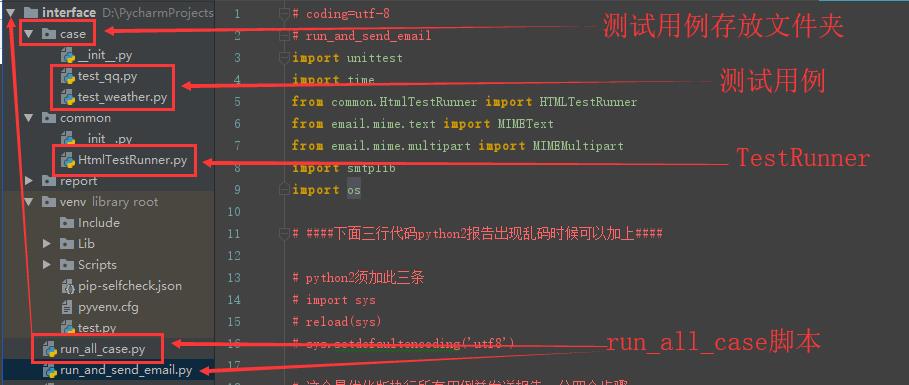python接口自动化测试二十五:执行所有用例,并生成HTML测试报告
Posted 向前走。
tags:
篇首语:本文由小常识网(cha138.com)小编为大家整理,主要介绍了python接口自动化测试二十五:执行所有用例,并生成HTML测试报告相关的知识,希望对你有一定的参考价值。

import requests
import unittest
class TestQQ(unittest.TestCase):
\'\'\'测试QQ号接口\'\'\' # 此注释将展示到测试报告的测试组类
def test_qq(self):
\'\'\'测试QQ号码,正确的appkey\'\'\' # 此注释将展示到测试报告的用例标题
url = \'http://japi.juhe.cn/qqevaluate/qq\'
par = {
\'key\': \'8dbee1fcd8627fb6699bce7b986adc45\',
\'qq\': \'907728701\'
}
# 发送post请求
r = requests.post(url, params=par)
print(r.text) # 获取返回的结果
result = r.json()[\'reason\']
print(result)
# 断言
self.assertTrue(\'success\' == result) # 断言:\'success\' == result
self.assertTrue(\'success\' in r.text) # 断言:\'success\' 在 r.text的返回内容里面
self.assertIn(\'success\', r.text) # 断言:\'success\' 在 r.text的返回内容里面
# 断言:\'success\' == result
self.assertEqual(\'success\', result, msg=\'失败的时候,打印这里\')
def test_qq_appker_error(self):
\'\'\'测试QQ号码,错误的appkey\'\'\' # 此注释将展示到测试报告的用例标题
url = \'http://japi.juhe.cn/qqevaluate/qq\'
par = {
\'key\': \'8dbee1fcd8627fb6699bce7b986adc45\',
\'qq\': \'907728701\'
}
# 发送post请求
r = requests.post(url, params=par)
print(r.text) # 获取返回的结果
result = r.json()[\'reason\']
print(result)
# 断言
self.assertTrue(\'success\' == result) # 断言:\'success\' == result
self.assertTrue(\'success\' in r.text) # 断言:\'success\' 在 r.text的返回内容里面
self.assertIn(\'success\', r.text) # 断言:\'success\' 在 r.text的返回内容里面
# 断言:\'success\' == result
self.assertEqual(\'success\', result, msg=\'失败的时候,打印这里\')
if __name__ == \'__main__\':
unittest.main
import requests
import unittest
class TestWeather(unittest.TestCase):
\'\'\'测试天气预报接口\'\'\' # 此注释将展示到测试报告的测试组类
def test_Weather(self):
\'\'\'可用次数超限\'\'\' # 此注释将展示到测试报告的用例标题
url = "http://v.juhe.cn/weather/index"
par = {
"cityname": "深圳", # 城市名或城市ID,如:"苏州",需要utf8 urlencode
"dtype": "json", # 返回数据格式:json或xml,默认json
"format": "1", # 未来7天预报(future)两种返回格式,1或2,默认1
"key": "80b4d4e1d870d257d3344fcf2d08f64a" # key须申请
}
r = requests.get(url, params=par)
print(r.text) # 获取返回的结果
result = r.json()[\'reason\']
print(result)
# 断言
self.assertEqual(\'reason\', result)
self.assertIn(\'reason\', r.text)
self.assertTrue(\'reason\'in r.text)
def test_Weather_appkey_error(self):
\'\'\'错误的key\'\'\' # 此注释将展示到测试报告的用例标题
url = "http://v.juhe.cn/weather/index"
par = {
"cityname": "深圳", # 城市名或城市ID,如:"苏州",需要utf8 urlencode
"dtype": "json", # 返回数据格式:json或xml,默认json
"format": "1", # 未来7天预报(future)两种返回格式,1或2,默认1
"key": "8dfghfhgfhgfh" # key须申请
}
r = requests.get(url, params=par)
print(r.text) # 获取返回的结果
result = r.json()[\'reason\']
print(result)
# 断言
self.assertEqual(\'reason\', result)
self.assertIn(\'reason\', r.text)
self.assertTrue(\'reason\'in r.text)
# run_all_case
import unittest
import os
# 从工程下面的第一层开始导入
from common.HtmlTestRunner import HTMLTestRunner
# 用例存放的路径
# startdir = \'D:\\PycharmProjects\\interface\\case\' # 绝对路径,容易出错
# 获取当前脚本的路径
curPath = os.path.dirname(os.path.realpath(__file__)) # 获取文件路径
startdir = os.path.join(curPath, \'case\') # 测试用例路径
# 获取测试报告:\'report.html\'路径
reportPath = os.path.join(curPath, \'report\', \'report.html\')
# 匹配规则
rule = \'test*.py\'
discover = unittest.defaultTestLoader.discover(startdir, rule)
print(discover)
# 生成HTML格式的报告
fp = open(reportPath, \'wb\') # 把测试报告以二进制的规则写进“report_report.html”文件中
runner = HTMLTestRunner(fp,
title=\'钟叶海的接口测试报告\', # 报告标题
description=\'报告如下:\', # 报告的描述
verbosity=2, # 将注释在测试用例中展示
retry=1 # 失败后,重跑1次(次数可随意更改)
)
runner.run(discover)
fp.close() # 写完后关闭HTML报告
# 生成TXT格式的报告
# runner = unittest.TextTestRunner()
# runner .run(discover)
# 运行所有用例,以邮件发送结果
# coding=utf-8
# run_and_send_email
import unittest
import time
from common.HtmlTestRunner import HTMLTestRunner
from email.mime.text import MIMEText
from email.mime.multipart import MIMEMultipart
import smtplib
import os
# ####下面三行代码python2报告出现乱码时候可以加上####
# python2须加此三条
# import sys
# reload(sys)
# sys.setdefaultencoding(\'utf8\')
# 这个是优化版执行所有用例并发送报告,分四个步骤
# 第一步加载用例
# 第二步执行用例
# 第三步获取最新测试报告
# 第四步发送邮箱 (这一步不想执行的话,可以注释掉最后面那个函数就行)
# 当前脚本所在文件真实路径
cur_path = os.path.dirname(os.path.realpath(__file__))
def add_case(caseName="case", rule="test*.py"):
\'\'\'第一步:加载所有的测试用例\'\'\'
case_path = os.path.join(cur_path, caseName) # 用例文件夹
# 如果不存在这个case文件夹,就自动创建一个
if not os.path.exists(case_path): os.mkdir(case_path)
print("test case path:%s" % case_path)
# 定义discover方法的参数
discover = unittest.defaultTestLoader.discover(case_path,
pattern=rule,
top_level_dir=None)
print(discover)
return discover
def run_case(all_case, reportName="report"):
\'\'\'第二步:执行所有的用例, 并把结果写入HTML测试报告\'\'\'
now = time.strftime("%Y_%m_%d_%H_%M_%S")
report_path = os.path.join(cur_path, reportName) # 用例文件夹
# 如果不存在这个report文件夹,就自动创建一个
if not os.path.exists(report_path): os.mkdir(report_path)
report_abspath = os.path.join(report_path, "result.html")
print("report path:%s" % report_abspath)
fp = open(report_abspath, "wb")
runner = HTMLTestRunner(fp,
title=\'报告的标题:这个是我的接口项目\', # 报告标题
description=\'报告如下:\', # 报告的描述
verbosity=2, # 将注释在测试用例中展示
retry=1 # 失败后,重跑1次(次数可随意更改)
)
# 调用add_case函数返回值
runner.run(all_case)
fp.close()
def get_report_file(report_path):
\'\'\'第三步:获取最新的测试报告\'\'\'
lists = os.listdir(report_path)
lists.sort(key=lambda fn: os.path.getmtime(os.path.join(report_path, fn)))
print(u\'最新测试生成的报告: \' + lists[-1])
# 找到最新生成的报告文件
report_file = os.path.join(report_path, lists[-1])
return report_file
def send_mail(sender, psw, receiver, smtpserver, report_file, port):
\'\'\'第四步:发送最新的测试报告内容\'\'\'
with open(report_file, "rb") as f:
mail_body = f.read()
# 定义邮件内容
msg = MIMEMultipart()
body = MIMEText(mail_body, _subtype=\'html\', _charset=\'utf-8\')
msg[\'Subject\'] = u"自动化测试报告"
msg["from"] = sender
msg["to"] = str(receiver) # 只能字符串
msg.attach(body)
# 添加附件
att = MIMEText(open(report_file, "rb").read(), "base64", "utf-8")
att["Content-Type"] = "application/octet-stream"
att["Content-Disposition"] = \'attachment; filename= "report.html"\'
msg.attach(att)
try:
smtp = smtplib.SMTP()
smtp.connect(smtpserver) # 连服务器
smtp.login(sender, psw)
except:
smtp = smtplib.SMTP_SSL(smtpserver, port)
smtp.login(sender, psw) # 登录
smtp.sendmail(sender, receiver, msg.as_string())
smtp.quit()
print(\'test report email has send out !\')
if __name__ == "__main__":
all_case = add_case() # 1加载用例
# # 生成测试报告的路径
run_case(all_case) # 2执行用例
# # 获取最新的测试报告文件
report_path = os.path.join(cur_path, "report") # 用例文件夹
report_file = get_report_file(report_path) # 3获取最新的测试报告
# #邮箱配置
# sender = "yoyo@qq.com"
# psw = "xxx"
# smtp_server = "smtp.qq.com"
# port = 465
# receiver = "yoyo@qq.com"
# send_mail(sender, psw, receiver, smtp_server, report_file, port) # 4最后一步发送报告
以上是关于python接口自动化测试二十五:执行所有用例,并生成HTML测试报告的主要内容,如果未能解决你的问题,请参考以下文章